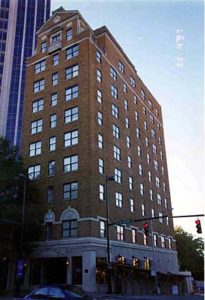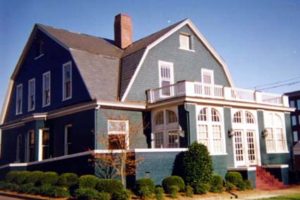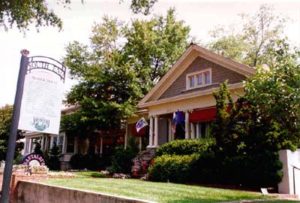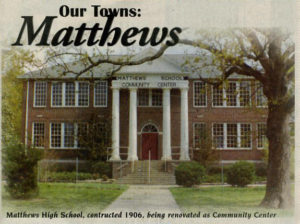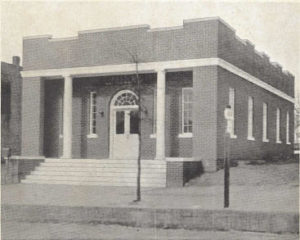This report was written on September 5, 1988
1. Name and location of the property: The property known as the Mayfair Manor is located at 237 North Tryon Street, Charlotte, N.C.
2. Name, address and telephone number of the present owner of the property: The owner of the property is:
Dunhill Associates Ltd. Partnership
PO Box 37321
Charlotte, N.C., 28237
Telephone: 704/377-0517
3. Representative photographs of the property: This report contains representative photographs of the property.
4. A map depicting the location of the property: This report contains a map which depicts the location of the property.
5. Current Deed Book Reference to the property: The most recent deed to this property is recorded in Mecklenburg County Deed Book 5580, Page 009. The Tax Parcel Number of the property is: 078-013-16.
6. A brief historical sketch of the property: This report contains a brief historical sketch of the property prepared by Paula M. Stathakis.
7. A brief architectural description of the property: This report contains a brief architectural description of the property prepared by Nora Mae Black.
8. Documentation of why and in what ways the property meets the criteria for designation set forth in N.C.G.S. 160A-399.4:
a. Special significance in terms of its history, architecture, and/or cultural importance: The Commission judges that the property known as the Mayfair Manor does possess special significance in terms of Charlotte-Mecklenburg. The Commission bases its judgment on the following considerations: 1) the Mayfair Manor, erected in 1929, was designed by Louis H. Asbury, an architect of local and regional importance; 2) the initial owners of the Mayfair Manor, Drs. J. P. Matheson and C. N. Peeler, were prominent citizens of Charlotte; 3) the Mayfair Manor, because it was designed to accommodate some permanent residents, documents the multi-functional nature of Uptown Charlotte in the late 1920’s; and 4) the Mayfair Manor makes an important contribution to the historic streetscape of North Tryon Street, a major axial thoroughfare in Charlotte.
b. Integrity of design, setting, workmanship, materials, feeling, and/or association: The Commission contends that the architectural description by Nora Mae Black which is included in this report demonstrates that portions o the Mayfair Manor meet this criterion.
9. Ad Valorem Tax Appraisal: The Commission is aware that designation would allow the owner to apply for an automatic deferral of 50% of the Ad Valorem taxes on all or any portion of the property which becomes “historic property.” The current appraised value of the improvement is $257,350. The current appraised value of the .80 acres of land is $104,940. The total appraised value of the property is $362,290. The most recent annual Ad Valorem tax bill on the property was $4,712.67. The property is zoned UMUD.
Date of Preparation of this Report: September 5, 1988
Prepared by: Dr. Dan L. Morrill
Charlotte-Mecklenburg Historic Properties Commission
1225 S. Caldwell St.
Charlotte, N.C., 28203
Telephone: 704/376-9115
Paula M. Stathakis
August 8, 1988
The Mayfair Manor was built on the corner of West Sixth Street and North Tryon Street in 1929 by Drs. J.P. Matheson and C.N. Peeler, who were perhaps better known as two of the founders of the Charlotte Eye, Ear, Nose, and Throat Hospital. 1 The ten story, 100 room hotel was intended for use by permanent and transient guests, with fifty rooms reserved for permanent residents. The earliest administration of the hotel included C.L. Lassiter, manager, J.W. Cole, assistant manager, C.B. Holmes, night manager, and W.R. Albea, dining room manager. 2 The Mayfair’s location was well suited for either the resident or the guest because it was situated only two blocks north of the city square, in close proximity not only to the heart of the business district but also to the many amenities downtown Charlotte had to offer patrons. Various small shops were well within walking distance of the Mayfair Manor as were larger establishments such as Ivey’s and Belk’s department stores and Montaldo’s. The Carolina Theater and the Charlotte Public Library were across the street from the hotel. The Tryon Cafe, Karnezes Confectioners, Sanitary Bakery, George Washington Lunch, Carolina Cafe, and Ridgeway’s Bakery would surely satisfy any culinary need that might conceivably be found lacking in the Mayfair restaurant. Second Presbyterian Church, First Baptist Church, and St. Peter’s Episcopal Church were all situated within two blocks. 3
The hotel stands on the site formerly occupied by the Tryon Street Methodist Episcopal Church, which purchased the property in 1862 from Joel A. Huggins for $2300.00. 4 The Tryon Street Methodist Episcopal Church sold the property to Home Real Estate and Guaranty Company on May 5, 1926 for $250,000.00. 5 On July 31, 1926, the property was purchased by Dr. J.P. Matheson with the provision that the church had the right to remove detachable personal property in the church, and the right to retain the church and Sunday School buildings without rent for a period of 18 months, beginning May 5, 1926. 6 By 1928, Matheson had hired Charlotte architect Louis Asbury to design the hotel. This agreement is listed as job number 723 in Asbury’s log book dated September 28, 1928 and is described as an apartment/hotel. 7 The structure destined to become the Mayfair Manor was unveiled for public inspection on the evening of November 15, 1929, a little more than a year later. 8
The Mayfair Manor debuted as a bright spot in the pall cast by the dramatic crash of the stock market just a month earlier. The same newspaper that duly reported a sluggish stock market also presented an enthusiastic two page tribute to Charlotte’s newest hotel.9 Much of the spread was dominated by contractors who had taken part in various stages of the hotel’s construction, and who took advantage of the opportunity not only to advertise their wares, hut to also tantalize the public with their specific contribution to the hotel. For example, the tile and marble work in the mezzanine and the tenth floor were an exact replica of that found in Atlanta’s Biltmore Hotel, the tile floor of the dining room was made of a material described as tile-tex , which was guaranteed for “life time service, a low initial cost, and no maintenance cost.” The furnishings came from McCoy’s Furniture of South Tryon Street, and the “Iron Fireman”, a new automatic stoker furnace was installed by A.Z. Price Company, Inc. 10
The unidentified reporter who wrote the preview article about the Mayfair Manor for the Charlotte Observer was ecstatic. 11 Adjectives such as “impressive”, “modern”, “luxurious”, and “massive” pepper the journalist’s narrative. This article is a valuable source of information about the original design and interior of the Mayfair Manor. The reporter began his tour of the building in the lobby which was summarily described as “impressive”; the floors were a terrazo with a tile base, the walls were covered with a material called craftex, the woodwork was crafted in walnut, and the fixtures were made of bronze. A “huge oven fireplace” was the focal point of the lobby. It was in this tastefully decorated lobby that one might also purchase cigars, cigarettes, and tasty Martha Washington Candy. The Mayfair Manor was the sole agent for Martha Washington Candy in Charlotte. Beneath the lobby on Sixth Street was the Mayfair Manor Barber Shop, managed by C.M. Brady, who supervised a five chair and one manicurist operation. The mezzanine had a lounge where guests could relax and meet their friends.
French doors marked the entrance to the dining room, the decor there followed the walnut and bronze motif of the lobby. Arched windows, craftex walls in soft colors, and a black and brown checked tile-tex floor all bestowed upon the dining room an “air of dignity”. The kitchen was described as spacious with the latest in cooking conveniences. A sampling of the original kitchen inventory of the Mayfair Manor included an electric dishwasher, a sterilizer with a 5000 dish capacity, steam tables, electric potato peelers, and mixing machines. A ventilating system capable of changing the kitchen air every three minutes was also on the list of notable extras. A skylight was built into the kitchen ceiling for the benefit of the workers. The dining room management planned to include a bakery in the future, and a special dessert and salad department was already incorporated into the kitchen organization.
“Every room has a bath” hailed the reporter as he continued his armchair tour. Tiled baths in various colors with tubs and showers were in each room. The rooms were furnished in “living room style” with double or twin Murphy beds, “luxurious” carpets and “fashionable” wallpapers. Each room had individual telephone service. The tenth floor was designed as a penthouse suite of “two skyscraper piazzas” which afforded what the reporter considered great views of Charlotte. Dr. Matheson planned to occupy the top floor along with Mr. Julian H. Little, president of the Independence Trust Company, Dr. Leinbach, and Mr. Little’s two nieces. 12
References were made in the article to a previously existing Mayfair Manor, and that the same high quality one had come to expect from the old establishment may be observed in the new one as well. Evidence of the “old” Mayfair Manor is scarce, but it was listed in the 1929 Charlotte City Directory under the management of C.L. Lassiter at 406 North Tryon Street, approximately two blocks north of the “new” Mayfair Manor. The new Mayfair Manor was the culmination of thirty years of effort by Mrs. Fannie L. Holmes, who began her career in Charlotte with a modest dining room and boarding house at 513 South Tryon Street. Mrs. Holmes, a Statesville native, ran this boarding house together with C.L. Lassiter. 13 By 1930, Mrs. Holmes had acquired two other businesses: The Hawthorne Dining Room and The Mayfair Manor. The 1930 Charlotte City Directory lists C.L. Lassiter as the president of the Mayfair Manor Inc., Mrs. Fannie L. Holmes was the vice-president, and Emmet S. Gray, as the secretary-treasurer. 14
Thus, the Mayfair Manor entered into Charlotte history. It was not the biggest, nor the grandest of our hotels, but it was considered quite fine in its day. In 1929, there were no less than fifteen hotels in Charlotte. The largest were the Charlotte Hotel at 239 West Trade and the Clayton Hotel at the corner of Church and Fifth streets. The Charlotte Hotel was undoubtedly the hallmark of the city, boasting a fireproof structure with 400 rooms, 400 bathrooms, a European Plan, and a dining room visited by such dignitaries as President and Mrs. Franklin and Roosevelt. The Mayfair Manor does not seem to have attracted such stellar guests, presumably because it was built for different purposes. The Mayfair Manor quietly thrived, however, on its corner long after the demolition of the Clayton Hotel, and it appears that it will outlive the Charlotte which was recently scheduled for demolition.
Dr. Matheson died in August 1937, and the property was acquired by the Mayfair Realty Corporation shortly afterward. 15 On September 1, 1959, the Mayfair Realty Corporation sold the property to Dwight L. Phillips. The new proprietor spent $225,000.00 in renovations and improvements on the hotel. 16 In December 1960, D.L. Phillips and his wife Louise sold the property to D.L. Phillips, Builders of North Carolina. 17 Following this transaction, the name of the hotel changed to the James Lee Motor Inn. 18 By October 1965, D.L. Phillips Investment Builders acquired additional property to the rear of the hotel. 19 These two tracts were sold in December 1980 to A.B. Wilkins Jr., owner of Delta Capital, for $300,000.00. 20 This transaction began what was to result in an unproductive series of acquisitions of the property by various investors who hoped to upgrade the hotel, which had suffered as the result of the decline of downtown Charlotte, into fashionable condominiums. The previous hotel owner, Charles Kinnard, had intentions of doing this himself, but could not afford the staggering cost of conversion estimated at $225,000.00 per floor. In December 1980, A.B. Wilkins announced his intention to work with Kinnard toward this end. 21
By February 1981, Kinnard and Wilkins came to an impasse. Kinnard placed an advertisement in the Charlotte papers announcing that the property was for sale by the owner; the ad was quickly denied by Wilkins. Kinnard’s actions were based on his desire to buy the hotel back from Wilkins. Therefore, Wilkins gave Kinnard an option to buy the hotel back if he could raise the funds. Kinnard’s time on this option had expired when he placed the ad. At that point, Wilkins had no interest in helping Kinnard, and he had already made plans for a joint renovation with another investor. 22
Wilkins posted signs around the hotel notifying the tenants that the hotel would close October 1, 1981, and that it would later re-open as a luxury hotel. 23 Wilkins’s plans never came to fruition. He sold the James Lee Motor Inn on January 4, 1982 for $392,000.00 to an investment firm of the Netherlands-Antilles , Elko Corporation, N.V., which planned to convert the hotel into a $4 million office condominium project, with completion projected for the summer of that year. 24 The renovation supervisor for Elko, Mr. Farley Gharagozlou, disclosed that the interior of the hotel had been completely stripped, and that future plans included the installment of a coffee shop in the basement and a restaurant in the penthouse. 25 These plans suddenly changed when the Elko Corporation decided to convert the James Lee Motor Inn into an elegant hotel, the Uptown Nova Plaza, which delayed the completion until summer 1983. 26
As the projected opening deadline drew near, the Charlotte News reported in May 1983 that an internal re-organization of the Elko Corporation would delay the project for an unspecified time.27 The fate of the former Mayfair Manor was vague at best, and the structure stood useless for another three years. Burt Gellman, whose firm owns Jonathan’s, a fashionable downtown restaurant one block north of the hotel site, made an unsuccessful bid to acquire the property in 1984. The Elko Corporation allegedly reneged on an agreement to sell the vacant hotel to him, and he took the matter to court in 1985, but he never gained the property. 28
Fallswood Investment Inc. purchased the hotel in May 1986, and then sold the property on December 18, 1986 to Omniswiss Properties Ltd. 30 The present owners of the property, The Dunhill Hotel Associates, purchased the hotel from Omniswiss Properties on August 6, 1987. 31 After six years of uncertainty, the former Mayfair Manor has a new lease on life. The Dunhill Hotel Associates have returned to the idea of restoring the building to a luxury hotel. The revival of this structure will be an asset to the Charlotte community, not only as a new and viable business, but also as a tangible part of Charlotte’s past.
ENDNOTES
1 Wade Harris, ed. The City of Charlotte and the County of Mecklenburg. Charlotte: Chamber of Commerce, 1924.
2 The Charlotte Observer 15 November 1929, p.10.
3 Sanborn Fire Insurance Maps 1929, Sanborn Map Company, New York. Skeleton Maps 2 and 3, sections 2a and 3b; Charlotte City Directory, 1929.
4 Mecklenburg County Registry of Deeds. Deed Book 4 pg. 791.
5 Mecklenburg County Registry of Deeds. Deed Book 625 pg. 225.
6 Mecklenburg County Registry of Deeds. Deed Book 628 pg. 511.
7 Southern Historical Collection, Louis Asbury Papers, No. 4237. University of North Carolina-Chapel Hill.
8 The Charlotte Observer 15 November 1929, p. 11.
9 Ibid., p. 10, 11.
10 Ibid., p. 10.
11 Ibid., p. 11. All information concerning the original interior of the hotel was taken from this article.
12 Ibid.; Charlotte City Directory, 1930.
13 Charlotte City Directory, 1926.
14 Ibid., 1930.
15 Records of the Mecklenburg Medical Society; Mecklenburg County Registry of Deeds. Deed Book 1120-254.
16 The Charlotte News 21 October 1981, p. 1.
17 Mecklenburg County Registry of Deeds. Deed Book 2220 pg. 46
18 The Charlotte Observer 8 October 1985, p. 12a.
19 Mecklenburg County Registry of Deeds. Deed Book 2689 pg. 308.
20 Mecklenburg County Registry of Deeds. Deed Book 4376 pg. 298. The Charlotte Observer 25 January 1981, p. 5b.
21 The Charlotte Observer 21 January 1981, p. 5b.
22 The Charlotte News 12 February 1981, p. 12a.
23 Ibid., 17 September 1981, p. 13a.
24 Mecklenburg County Registry of Deeds. Deed Book 4500 pg. 395
25 The Charlotte Observer 11 April 1982, p. 5b.
26 The Charlotte Observer 25 October 1982, p. 1a.
28 Ibid., 10 August 1985, p. 12a.
29 Mecklenburg County Registry of Deeds. Deed Book 5223 pg. 339, Deed Book 5403 pg. 647.
30 Mecklenburg County Registry of Deeds. Deed Book 5580 pg. 9.
By Nora Mae Black
The former Mayfair Hotel, located on the northwest corner of the intersection of North Tryon Street and 6th Street, is an example of one of the small, privately-owned hotels that provided a resting place for travelers to Charlotte during the beginning of this century.
The design of the building was executed by Louis H. Asbury, a Charlotte architect. The building was originally known as the Mayfair Hotel. Later it became the James Lee Motor Hotel. A top to bottom renovation of the building is on the drawing board. Under this proposal, the building would become a luxury hotel known as The Dunhill Hotel.
The building consists of eleven floors. There is a basement with a small sub-basement. The first floor, or Tryon Street level, housed the lobby. At the northwest end of the building, the first floor gives way to two mezzanine levels. The protective railings are missing from the lobby level and the upper mezzanine; however, a metal stairway still connects the levels.
Above the lobby, or first floor, there are eight floors that formerly contained the guest rooms. The ninth floor contained a penthouse suite for the owner of the Mayfair Hotel as well as a few guest rooms.
Exterior
The Mayfair Hotel has a nine-story symmetrical facade facing North Tryon Street. The West 6th Street facade overlooks Discovery Place and from the upper floors, Fourth Ward. The entire structure is covered with a sand-colored brick (much darkened due to dirt) laid in running bond. Cast stone decorates the remains of the North Tryon Street entrance and the brick facade at the top of the second floor windows. The cast stone continues on the West 6th Street facade and becomes a surround for the tops of the last three windows on the second floor. A cast stone course wraps all four facades at the top of the eighth floor windows. All windows have cast stone sills. The original windows were removed during an earlier renovation and replaced with double-hung residential windows. Double windows are usually 6/6 while others are 8/8 and 2/2. On the North Tryon Street facade the three-ranked windows consist of a single window flanked by pairs of adjacent windows. On the 6th Street facade the seven-ranked windows consist of the following pattern a single window, a pair of adjacent windows, a single window, a single window, a single window, a pair of adjacent windows, and a single window. The south facade has an irregular pattern of windows of several different sizes. The west, or rear, facade has three windows of differing sizes on each floor above the second floor.
Most of the North Tryon Street level facade has been removed. However, it is still possible to see the remains of Corinthian capitals that once decorated the pilasters at the front entrance. The most impressive remaining part of the facade is at the penthouse level. There the owner’s living quarters overlooked North Tryon Street. The sitting room did not extend the full width of the facade, it became a square room flanked by two balconies. The brick of the facade formed the protective barrier on the Tryon Street elevation. Topping the protective barrier, each balcony had a cast stone urn and a cast stone circular medallion for decoration. On the north and south elevations, the small balconies have balustrades of cast stone with flower boxes. On the Tryon Street elevation a narrow center balcony, flanked by single windows, projects over the street. A half round pediment extends over the balcony. To each side of the pediment decorative cast stone ovals are laid into the brick over the windows. There is a circular stone medallion in the center of the pediment. A raking cornice of cast stone tops the pediment. A cornice of cast stone continues part way around the side (north and south) elevations.
Interior
Much of the interior of the building was destroyed during an earlier attempt at renovation. Masonry interior bearing walls that provided wind bracing were removed and replaced with steel structural members. The original elevators were removed and never replaced. Part of the roof is gone with the result that much water enters the building. At places, the concrete floors have holes in them. Ceilings have been taken down exposing the open web steel joists. Plaster and other wall coverings have been removed exposing the structural steel frame. The partitions that separated the ‘guess rooms have been torn down.
The most intact portion of the original building is the penthouse suite of the owner. The penthouse has a marble floor. A fireplace in the sitting room overlooking North Tryon Street has an ornate carved plaster mantel with a green marble fire surround. Plaster crown molding with carved dentils decorate the sitting area. In another room of the owner’s suite, original wood paneling covers the walls.
In Closing
The Mayfair Hotel building provides a solid architectural presence at the corner of North Tryon Street and 6th Street. Its proximity to Discovery Place, Spirit Square and the new market make it an ideal overnight location for visitors to Charlotte. Those having business in the central business district would also find that it is within walking distance of the many office towers. Since so much of the original exterior fabric is unchanged and in relatively good condition, it could be rehabilitated and become a landmark building in a revitalized North Tryon Street corridor.
SPECIAL NOTE: The Mayfair Manor has been substantially renovated since the above architectural description was written. This renovation, however, has not destroyed those portions of the property which possess historic significance.

